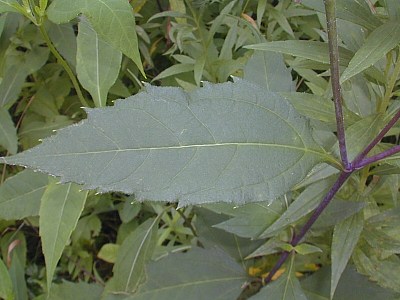Description: This perennial wildflower is about 3-5' tall; it is erect and branches occasionally. The stems are light green, pale reddish green, or purple; the upper stems have short bristly hairs, while lower stems are glabrous and sometimes glaucous. The lower and middle leaves are opposite, while the upper leaves are alternate; they spread outward from the stems. The leaf blades are up to 7" long and 3" across; they are broadly lanceolate to ovate with long slender tips and sharply serrated margins. The upper surface of each leaf is dark green and rough in texture, while the lower surface is light green and nearly hairless. The petioles of the leaves are about ½–1½" long; they are somewhat winged near the leaf blade, but become more narrow toward the stem. The upper stems terminate in yellow flowerheads on naked stalks (peduncles) of varying length. Each flowerhead is about 2–3½" across, consisting of 8-12 ray florets that surround numerous disk florets in a central disk. The petal-like ray florets are bright yellow and oblong in shape, while the disk florets are yellow and tubular. The base of each flowerhead consists of several overlapping bracts. These floral bracts are light green, linear-lanceolate, and ciliate along their margins; they often curve backward. The blooming period occurs from mid-summer to early fall and lasts about 1–1½ months. Each fertile floret is replaced by a dark achene about 1/8" (3 mm.) in length (or a little longer) that is oblongoid and slightly flattened. The root system is fibrous and rhizomatous. Vegetative colonies of plants are often formed from the rhizomes.

Cultivation:
The
preference is partial sun or dappled sunlight, moist to mesic
conditions, and a rich loamy soil. Like other perennial sunflowers,
this species may spread aggressively in some situations.
Range & Habitat:
The native Ten-Petal Sunflower is occasional in Illinois and widely
scattered
throughout the state; it is largely absent in south-central Illinois
(see Distribution
Map). Habitats include open woodlands, woodland borders,
savannas, partially shaded areas along rivers, meadows, and thickets.
Occasional disturbance is beneficial if it prevents excessive shade
from overhead trees.
Faunal Associations:
The nectar and pollen of the flowerheads attract primarily bees. These
bee visitors include honeybees, bumblebees, little carpenter bees
(Ceratina spp.), long-horned bees (Melissodes spp.), cuckoo bees
(Coelioxys spp.), leaf-cutting bees (Megachile spp.), and Halictine
bees (including green metallic bees). Other floral visitors include
Syrphid flies, bee flies (Bombyliidae), and butterflies (Wilhelm &
Rericha, 2017). Many kinds of insects also feed destructively on the
foliage, stems, sap, and other parts of sunflowers (Helianthus spp.).
These insect feeders include weevils, larvae of long-horned beetles,
leaf beetles, larvae of leaf-mining flies, larvae of gall flies, plant
bugs, aphids, leafhoppers, treehoppers, grasshoppers, larvae of tiger
moths (Arctiidae), larvae of owlet moths (Noctuidae), larvae of Tortrix
moths, and larvae of such brush-footed butterflies as the Gorgone
Checkerspot (Chlosyne gorgone), Silvery Checkerspot (Chlosyne nycteis),
and Painted Lady (Vanessa cardui). The Insect Table
provides more information about these and other species of insect
feeders. The seeds of sunflowers are an important source of food for
many songbirds, upland gamebirds, and crows (see Bird Table);
the Meadow Vole, Prairie Vole, and Groundhog also feed on these plants
(Martin et al., 1951/1961). Hoofed mammalian herbivores browse on the
foliage; this includes White-tailed Deer, cattle, and other livestock
(Voight Englund & Meyer, 1986; Georgia, 1919).

Photographic
Location:
A woodland opening at Meadowbrook Park in Urbana. The long slender
bracts of a flower bud can be seen in the upper leaf corner of the upper
photograph. In the lower left of the same photograph, the long slender
tip of a leaf blade is fully visible. Both photographs show the long
pointed teeth along the margins of the leaf blades.
Comments:
This is an attractive woodland sunflower that should be cultivated in
gardens more often. There are many species of sunflowers in Illinois
(both prairie and woodland) and they are often difficult to identify.
Ten-Petal Sunflower has the following characteristics that are useful
in identifying this species: 1) the margins of its leaf blades have
teeth that are long and pointed, 2) the tips of its leaf blades are
unusually long and slender, and 3) the floral bracts are unusually long
and slender. However, some populations of plants may have shorter teeth
on the leaf margins.